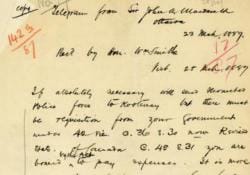
Modernization
Learn more about government’s intention to modernize the museum to protect our historic holdings and provide better access to our collections.

The BC Archives is working to provide digital copies of records to Indigenous families and communities that have a connection to the material. A recent example includes an 1887 government file that describes early settler-Indigenous conflict in the East Kootenays in detail. The scanned file has been provided to the Ktunaxa Nation Council.
On March 27, 2018 two collections from the Royal BC Museum—the Vancouver Island Treaties and the Ida Halpern fonds—were accepted for inscription on the Canadian Commission for UNESCO's Canada Memory of the World register. Highly valued by Indigenous communities, inscription on the register is recognition of the significance of these records.
Respectful field practices have been introduced by Royal BC Museum scientists. Local First Nations are now contacted before summer collecting trips are planned in their territories and museum scientists offer to collect duplicate samples that can be deposited with communities who have an interest in developing natural history collections. To date, duplicate collections of botanical material have been donated to the Kelly Lake First Nation and to the Treaty 8 Tribal Association.
Updates to the Royal BC Museum Natural History gallery will begin in 2018. Included in the refresh will be changes to the metanarrative and specimen labels to introduce Traditional Ecological Knowledge (TEK) as an important source of environmental information.
A three year plan has been launched to begin a major renewal and re-evaluation of all First Peoples gallery displays. This includes an updated interpretive plan and major design changes to represent contemporary living First Nations. All work is being completed in direct consultation with the First Nations Advisory and Advocacy Committee.
Indigenous partners were consulted in the planning of the Becoming BC gallery refresh (2018–21). These partners will introduce Indigenous and intercultural voices as an integral part of BC's historical narratives.
The Royal BC Museum frequently loans out cultural heritage to community members on request, as with a Chilkat Robe (RBCM 14768) that was loaned to family members for graduation ceremonies in 2015 and 2017. Museum conservators learned to perceive the robe as part of a living culture, recognize that it has value as a ceremonial object, and demonstrated positive caretaking practices for the preservation of cultural heritage.
The Royal BC Museum's Conservation department provides meaningful access to collections to artists who need to view a particular object (e.g. Haida Canoe). The detailed view of the materials and structure of objects is shared with the people who derive the most benefit from close examination of the object.